|
|
|
|
Random Thoughts About The Kingdom of Siam,
the Democracy of Thailand
|
|
|
|
|
|
|
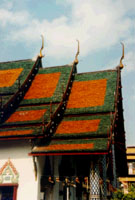 A multi-layered, tiled roof of a wat (temple) in Chang Rei, northern Thailand. At the top are three "chaw faws," a demon or cobra representation. A multi-layered, tiled roof of a wat (temple) in Chang Rei, northern Thailand. At the top are three "chaw faws," a demon or cobra representation.
|
|
Design: Thailand is the rococo capital of the world. France's King Louis XIV's architects and interior designers were bush league compared to what the people of Thailand have been doing for millennia.
Every available space or surface is a playground for bright tiles, mirrors, gold leaf and a pantheon of mythological creatures, demons, angels and gods.
Two factors seem to be most responsible for this elaborate design motif: first, Southeast Asia, and particularly Thailand is a melting pot, a very ancient one for the many cultures and peoples of Asia. The basic religion of the region is Buddhism with a strong admixture of Hinduism and primitive animism.
The result is religious scenes that look more like the bar scene from Star Wars, hybrid creatures like the Singha Vanara (half monkey, half lion), the Kinara (half human, half bird), Garuda (the King of Birds and mount of the Hindu God, Vishnu) and his mortal enemy, Naga (King of Serpents, the cobra), my personal favorite, Lord Ganesh (half human with three elephant heads facing each direction). These and many more are all painted, sculpted, carved or inlaid amidst a seeming infinite number of Buddha images in every pose.
|
|
|
|
 Looking at the complex of buildings, the Mahamontien, on the grounds of the Grand Palace in Bangkok. In this building is where the Royal Court is held, the coronation of the monarch is staged, and the residences of the first Kings of Thailand. Looking at the complex of buildings, the Mahamontien, on the grounds of the Grand Palace in Bangkok. In this building is where the Royal Court is held, the coronation of the monarch is staged, and the residences of the first Kings of Thailand.
|
|
|
The second factor seems to be that Thailand has the resources to do it. It's got the time (thousands of years of temperate tropical climate), gold to hammer into foil, plenty of manpower and skilled artisans, and tremendous teak forests.
It's not just the holy centers that get this degree of overblown attention. Simple homes, cafes and new buildings also get their share of the ornate. Even some of the simple thatched, bamboo huts we found in the mountains were graced with simple yet elegant design additions. More so, this same degree of highly formalized rococo can be seen in the country's dance, puppet shows and other cultural arts.
Dance: Classical dancers move with a maddeningly slow grace, their knees bent outward in the same way as the bow-legged Garuda. And their hands, often accentuated with long false nails are bent and contorted into twisted, unnatural shapes—especially one prevalent movement where the fingers actually seem to point backwards to the top of the hand.
|
|
|
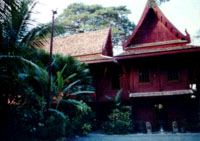 Jim Thompson House, Bangkok Jim Thompson House, Bangkok
|
|
|
|
Jim Thompson House: located up a quiet soi (alley) in the heart of Bangkok, is a mystery, an enigma, and a very special place—the home of Jim Thompson, a must see by any visitor to the capital city.
Jim Thompson was an American born in 1906, trained as an architect, and became involved with the OSS (Office of Strategic Services, the father of the CIA) in WWII, serving in Thailand. After the war he returned to New York, got bored, and came back to Thailand where he remained until his death.
|
|
|
|
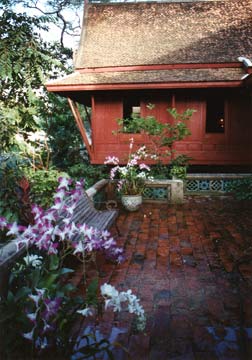 |
|
|
Thompson revived the silk industry of Thailand, and as a result became wealthy and honored. While he was busy doing this, he also collected old house parts and folk art from around the country, and used these to build a fabulous home along one of the klongs (canals) in Bangkok--a house that should not be missed by anyone visiting the city. In 1967, while on a walk in Malaysia, Thompson mysteriously disappeared—leading of course to a host of wild theories.
The Buddha: Everywhere you go and everything you touch in Thailand is branded in some way with religious designs, often mythological and bordering on the surreal. But the most prevalent of all images, even in the South of Thailand where Muslim factions appear, is the sacred images of Buddha. And many of the world's most important representations of the Prince are found in this ancient land.
|
|
|
|
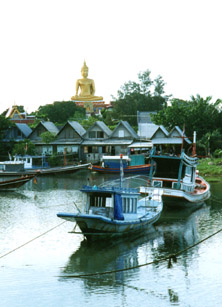 The Big Buddha dominates the harbor on the north end of the island, Koh Samui The Big Buddha dominates the harbor on the north end of the island, Koh Samui
|
|
|
|
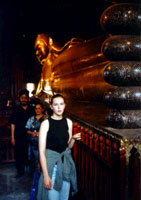 Samantha stands at the feet of the imposing gold gilt statue of the Reclining Buddha Samantha stands at the feet of the imposing gold gilt statue of the Reclining Buddha
|
|
|
|
|
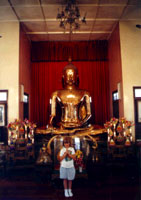 Cassidy stands before The Golden Buddha Cassidy stands before The Golden Buddha
|
|
|
|
This last one (where photos are not allowed) is located inside the Palace walls. The story goes (and it seems to have strong scholarly evidence to indicate it's true) is that this image (66 cm high, 48 cm wide at its lap) is carved from a single piece of jade. In 1434 A.D., lightening struck a "chedi" (a solid, conical monument) in a Buddhist monastery in northern Thailand. The structure was destroyed, but the monks found inside the ruins a large, stucco statue of the sitting Buddha which they promptly took to the abbot.
This sat around for a short while before he noticed that parts of the stucco were chipping away, revealing an underlying carved jade statue. He peeled away the rest of the covering and was amazed, as was everyone in the region when word spread. From miles around people came to pay worship. It wasn't long before the King of Chang Mai heard the tales and decided such a priceless work would be best placed in his palace. Three times he dispatched elephants to retrieve this treasure, and each time the elephant would come to a fork in the road and head the wrong way—and the King being no fool to such loud and clear messages allowed the statue to remain where it was for the next 32 years—until 1438.
But people being what we are, and Kings being what they are, this happy circumstance had to change. And for the next 310 years the Emerald Buddha was wrenched hither and yon, between various Kingdoms, into Laos, in and out of every nook and cranny until King Rama I (1778, while Americans were still trying to decide on a Capital and a Way) captured it and hauled it back to the new capitol he was building, a city that would be called Bangkok. And that is where this priceless reliquary has remained, the image of the Buddha that has looked over every coronation of every King of Siam and Thailand since then.
|
|
|
It should be noted that King Rama I had two costumes made for the Emerald Buddha, one for summer and one for the rainy season. King Rama III (1824 - 1851) also added one for winter. And to this day, one of the more important holidays in Bangkok is the changing of these costumes.
It must also be mentioned that everywhere you go in Thailand you see young and old men dressed in the saffron robes of a Buddhist monastery.
|
|
|
|
 |
|
|
Four monks on tour of the Grand Palace. Some carry their begging bowls, all are barefoot or in sandals, and they automatically provide a serene and contemplative anchor to the scene. Although, women (and girls) are not to touch, brush up against them or make any kind of contact
|
|
|
|
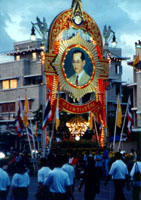 A picture of the King erected for his birthday, dominates a street in Bangkok A picture of the King erected for his birthday, dominates a street in Bangkok
|
|
|
|
His Majesty, The King: In 1938, Siamese students living in Paris led a bloodless revolution that ended the absolute monarchy of the country and established the present constitutional monarchy with elected governing bodies—and named the new country Thailand.
Siam had been ruled for millennia by Kings, most regional and warlord like. But slowly, starting in the 11th Century, power began to centralize into the hands of a succession of powerful Kings. This evolution became earnest in the 14th and 15th Century at Ayuthaya, a place that is now stately ruins only a few hours north of Bangkok.
And then in 1782 a new King was crowned, and thus began the Chakri Dynasty that leads to today's present King. It was this colorful and wise dynasty that founded Bangkok as the new capital, and conducted the extensive building projects that cover the country with beautiful structures and repositories of sacred and profane history.
|
|
|
|
For us, staying in a country with a very real Monarch was exciting. The people of Thailand love their King, and to do him disrespect in any way, even the slightest joke or inappropriate gesture is not condoned. On two occasions we went to movies in Bangkok—and before every movie, just after the coming attractions, the audience bolts to attention as a picture of the King is flashed on the screen, the national anthem is played, and scenes of his life and his help of his people and love of playing jazz are shown.
As Americans who fought so hard long ago to get away from a King at the same time this dynasty formed, it was strange to find ourselves reverently standing for a King, and respecting a Great Man.
|
|
|
|
|
|
|
|
|
|
|
|
|
|
|
|
|
|
|
|
|
|
|
|
|
|
|
|
|
|
|
|